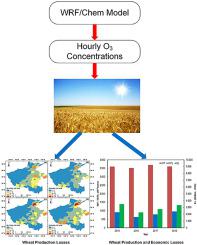Atmospheric Environment ( IF 4.2 ) Pub Date : 2021-08-05 , DOI: 10.1016/j.atmosenv.2021.118654 Tuanhui Wang 1, 2 , Lin Zhang 1, 2 , Shenghui Zhou 1, 3 , Tianning Zhang 2, 3 , Shiyan Zhai 1, 3 , Zhongling Yang 4 , Dong Wang 4 , Hongquan Song 1, 3

|
Ground-level ozone (O3) is a secondary air pollutant and has negative effects on crops, especially in China in recent years due to the sharply increasing precursors of O3. Based on the hourly O3 concentrations simulated by Weather Research and Forecasting model coupled with Chemistry (WRF/Chem) and AOT40 index (accumulation of hourly ozone concentrations exceed 0.04 ppm), we assessed the losses of yield and economy of winter wheat during 2015–2018 at the county level for a central province (Henan) of China. The O3 concentration and AOT40 during the wheat growing seasons (75-days, 44 days before and 30 days after mid-anthesis) showed a clearly increasing trend over nearly all counties. The annual mean AOT40 was 6.25 ppm h, 4.32 ppm h, 5.26 ppm h, and 6.87 ppm h from 2015 to 2018, respectively. The AOT40 and the loss of relative yield of winter wheat showed significant spatial and temporal variations at the county level. The annual mean relative yield loss of wheat for Henan during 2015–2018 was 12.8%, 8.8%, 10.8%, and 14.1%, respectively, and associated with 2140.10 million, 1318.57 million, 1683.03 million, and 2161.22 million US dollars, respectively. Results indicated that we should formulate more reasonable and stringent emission reduction measures to reduce the O3 pollution levels and ensure food security in China.











































 京公网安备 11010802027423号
京公网安备 11010802027423号